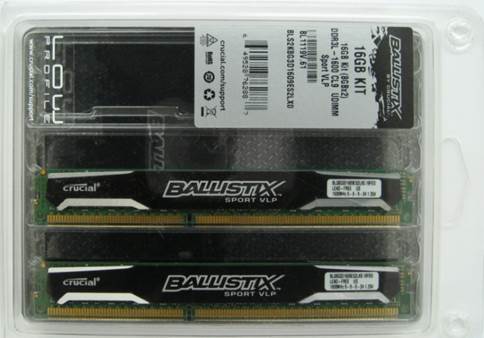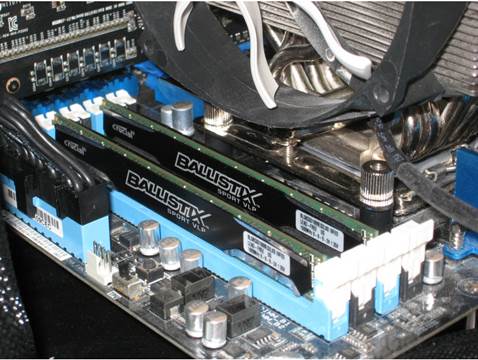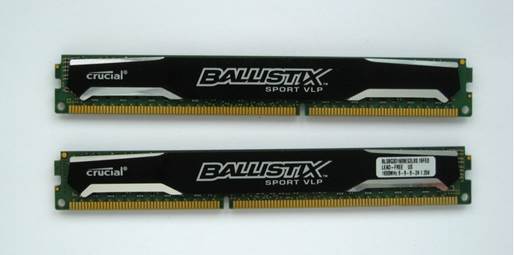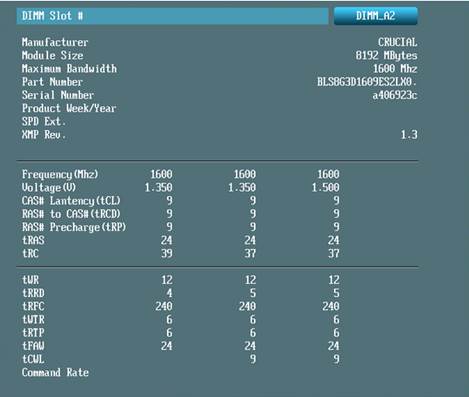Crucial
Ballistix Sport VLP DDR3-1600 2x8GB (BLS2K8G3D1609ES2LX0)
The second low-profile memory module from
Ballistix is called Sport. It is determined to be lower than Ballistix Tactical
LP. However, Ballistix Sport VLP turns out to be more interesting because VLP
stands for Very Low Profile. The extremely compact of this kind of memory
modules from Crucial Sport series has no alternatives from this or any other
producers.
The dual-channel DDR3-1600 kit includes two
8 GB memory modules, packaged like Ballistix Tactical LP. It is covered by
unified wraps which have spaces between. Nevertheless, the memory is always
firmly fixed inside.

Crucial
Ballistix Sport VLP
There are some similarities in the outside
appearance of Ballistix Sport VLP and Ballistix Tactical LP. Both have a
compact PCB with the height of 20mm, but Tactical LP is higher because of its
heatsinks. Sport VLP has simpler heatsink and its heatsink does not make the
whole module become higher. As a result, each module is not higher than 20mm.
In practice, these modules will be a little lower than the DIMM slots when
being installed.

Images
when installing
The cooler is absolutely not as efficient
as Ballistix Tactical LP’s. In fact, they have nothing better but the slim
aluminum bars. With the Black-anodized, they look very sharp and a shining edge
with the product’s logo right in the center. Therefore, their main target is to
make Ballistix Sport VLP seem to be like a luxury product for knowledgeable
users.

The
outside design
As the matter of fact, this kind of memory
module does not take the priority of a dedicated cooler. Besides, memory speed
is not lower than 1600. They work at reduced voltage. Like Tactical LP, Sport
VLP also meets the standard requirements of DDR3L so they can also work with
the voltage of 1.5 V.
However, heatsinks is not the basic
difference between two modules. Ballistix Sport VLP DDR3-1600 2x8GB is designed
for different operating modes as describing in the following specifications.
Official specifications
·
Dual-channel kit consists of two memory modules,
each is 8 GB
·
Nominal frequency: 1600 MHz
·
Timing: 9-9-9-24-2T
·
Supports XMP
·
Voltage: 1.35 V or 1.5 V
Sport VLP has
fast timings with CAS Latency is 9 whereas Tactical LP’s CAS latency is 8.
Otherwise, these two products are distinguished by their specifications as well
as XMP configurations.
XMP configuration describes two operating
modes with two voltage levels of 1.35 V and 1.5 V. From the opinion of the
producers, both of these two low-profile memory modules operate similar with
each other in DDR3L and DDR3 mode. The former one is more preferred in the
practical testing process because they help reducing power consuming. The other
XMP configuration is an offer for overclocking. It assures that if you increase
the voltage Ballistix Sport VLP (or Tactical LP), they will not be broken.

Ballistic
Sport VLP’s specifications
Beside two XMP configurations, there is a
SPD configuration describing DDR3-1333 mode to assure the compatibility with
the vast majority of current computer platforms.
As for chips employed, we cannot say any
other special thing. Their brands are unrecognizable. The only thing that we
could know is that the producer is Micron.

The
inside design
By this way, Ballistix Sport VLP and
Tactical LP have the same PCB design and the only difference is PCB color. We
doubt both are identical in terms of hardware, distinguishing based on the
outside design, XMP configuration and official specifications. However, we
should have a check in a practice test.
Configuration test
We will carry out the test of checking
Crucial Ballistix’s system memory on LGA 1155 system built on Asus P8Z77 – V –
Deluxe mainboard based on the newest Intel Z77 Express chipset. Since
overclocking memory modules are primarily purchased by technology fans, we have
used Intel Core i5 – 3570K processor overclocked to the frequency of 4.5 GHz.
As the result, a complete list of all
hardware and software components in the test is followed:
|
Parameters
in the test process
·
CPU: Core i5 – 3570 X, overclocked to the
frequency of 4.5 GHz (Ivy Bridge chip, 4 Cores, 6 MB L3)
·
CPU heatsink: NZXt Havik 140
·
Mainboard: ASUS P8Z77 – V – Deluxe (LGA 1155,
Intel Z77 Express)
·
Memory: Crucial Ballistix Tactical LP BLT2K8G3D1608ET3LX0
(2x8 GB, DDR3 – 1600, 8-8-8-24); Crucial Ballistix Sport VLP
BLS2K8G3D1609ES2LX0 (2x8 GB, DDR3 – 1600, 9-9-9-24)
·
Graphics card: Nvidia GeForce GTX 680 (2 GB /
256 bit GDDR5, 1006/6008 MHz)
·
Drive: Intel SSD 520 240 GB (SSDSC2CW240A3K5)
·
Power supplier: Corsair AX760i (80 Plus
Platinum, 760 W)
·
Operating system: Microsoft Windows 7 SP1
Ultimate x64
·
Drivers: Intel Chipset Driver 9.3.0.102; Intel
Management Engine Driver 8.1.2.1318 Intel Rapid Storage Technology
11.7.0.1013; NVIDIA GeForce 310.90 Driver
|